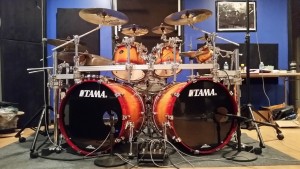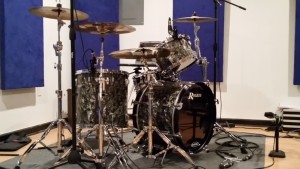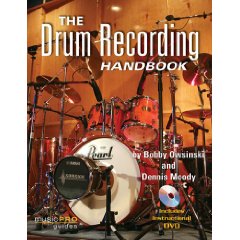
April 28, 2020
|
Posted by Jon (admin)

I’ve recently started jamming with some guys around the studio once in a while just for fun, but I ran into a slight problem: I need to keep my drum mics connected to my mic preamps so they’re always ready for recording drum tracks. However, I also needed to connect my drum mics to my live mixer (a Behringer X-Air XR18) so I can use my in ear monitors and add drums to the mix when jamming. So to put it simply, I needed a way to split the signals from my drum mics and send them to a couple of different sets of inputs. (more…)
 Categories: Live Sound, Recording, Reviews, Tips for Artists & Bands, Tips for Engineers
|
Categories: Live Sound, Recording, Reviews, Tips for Artists & Bands, Tips for Engineers
|  Tags: behringer, Drums, mic, microphone, mike, ms8000, Recording, Review, splitter
Tags: behringer, Drums, mic, microphone, mike, ms8000, Recording, Review, splitter

October 13, 2017
|
Posted by Jon (admin)

A common conversation I have around Christmas time each year goes something like this: “Hey, you play the drums, right? I want to buy a drum set for my child/grandchild/husband/etc., but I don’t know what to buy. What kind of drums should I buy, where should I buy them, and how much should I expect to spend?” I’ve had this same conversation so many times that it inspired me to write this article. So in the future, when people ask me, I can simply send them a link to the article, they can go read it, and (hopefully) find answers to their questions. As you’ll see, this isn’t an easy question with a quick and easy answer. Asking “what kind of drums should I buy?” is similar to asking “what kind of car should I buy?”, so it evokes a necessarily lengthy response. (more…)
 Categories: Bands, Drums
|
Categories: Bands, Drums
|  Tags: buying, choosing, DRUM, Drums, guide, set
Tags: buying, choosing, DRUM, Drums, guide, set

July 25, 2017
|
Posted by Jon (admin)

An all-important detail that isn’t mentioned in many articles about recording acoustic drums is how important it is to find the “sweet spot” in your room where the drums sound their best. I found this out the hard way. Since building my studio several years back, I’ve always set up the drums roughly centered along one of the longer walls (my room is 24′ x 22′), with the drummer’s back to the wall. This just seemed to be the logical place to set them up. It allowed me plenty of room to work around the kit when setting up the mics, allowed good visual communication between the drummer and the other band members, and it kept the kit somewhat out of the way for when people walk through the live room to the control room (which is on the opposite end of the building from the front door). It also allowed my own band plenty of room to set up a guitar amp on one side of the kit and a bass amp on the other for rehearsals, since that’s how things would normally be set up on stage during a live performance. (more…)
 Categories: Bands, Drums, Recording, Tips for Artists & Bands, Tips for Engineers
|
Categories: Bands, Drums, Recording, Tips for Artists & Bands, Tips for Engineers
|  Tags: Drums, Recording, sweet spot
Tags: Drums, Recording, sweet spot

May 9, 2012
|
Posted by Jon (admin)
 For several years, I’ve had some Sennheiser e604’s that I’ve always used for recording the toms on drum kits. Lately though, I had been particularly unimpressed with how my tom tracks have sounded, so I decided to try out a pair of the much-loved-for-toms, CAD M179’s. I only bought two M179’s and set one mic between my two high toms (10″ & 12″) and the other between my two floor toms (14″ & 16″). I engaged the -20 db pad on the M179’s and set the pattern to hypercardioid to try and minimize bleed. (more…)
For several years, I’ve had some Sennheiser e604’s that I’ve always used for recording the toms on drum kits. Lately though, I had been particularly unimpressed with how my tom tracks have sounded, so I decided to try out a pair of the much-loved-for-toms, CAD M179’s. I only bought two M179’s and set one mic between my two high toms (10″ & 12″) and the other between my two floor toms (14″ & 16″). I engaged the -20 db pad on the M179’s and set the pattern to hypercardioid to try and minimize bleed. (more…)
 Categories: Drums, Recording, Reviews, Tips for Engineers
|
Categories: Drums, Recording, Reviews, Tips for Engineers
|  Tags: CAD M179, Drums, Recording, Sennheiser e604, tom mics, toms
Tags: CAD M179, Drums, Recording, Sennheiser e604, tom mics, toms

September 8, 2011
|
Posted by Jon (admin)
![tuning-drums-1001[1]](http://silentsky.net/wordpress/wp-content/uploads/2011/09/tuning-drums-10011-300x243.jpg)
Most recordists will agree that acoustic drums are the most challenging instrument to record (and record well). One of the reasons (among several) is that a drum kit has so many moving parts that are prone to rattles, squeaks, buzzes, and other annoying sounds. It’s also quite a task to tune a drumkit, which always needs to be done prior to any recording session. (more…)
 Categories: Drums, Recording, Tips for Artists & Bands, Tips for Engineers
|
Categories: Drums, Recording, Tips for Artists & Bands, Tips for Engineers
|  Tags: DRUM, Drums, kit, preparing, recordings
Tags: DRUM, Drums, kit, preparing, recordings

November 19, 2009
|
Posted by Jon (admin)
It’s been my experience that many drummers both young and old have a real lack of knowledge when it comes to tuning their drums. A properly-tuned drumset will not only sound good, but it will also motivate the drummer to want to practice and play more. It’s kind of like the difference between driving a old beat-up clunker and racing around in a new sportscar. (more…)
 Categories: Drums, Recording, Tips for Artists & Bands, Tips for Engineers
|
Categories: Drums, Recording, Tips for Artists & Bands, Tips for Engineers
|  Tags: Drums, tips, tuning
Tags: Drums, tips, tuning

August 19, 2009
|
Posted by Jon (admin)
Playing drums is a physically-demanding activity, perhaps more so than playing any other musical instrument. A drummer will often be seated behind his kit for hours at a time for practicing, rehearsing, and performing. For this reason, it’s especially important to be comfortable when you play. One key that I’ve discovered to setting up my kit to make playing more comfortable is what I’ll call the “offset bass drum position”. (more…)
 Categories: Drums
|
Categories: Drums
|  Tags: Comfort, Drumming, Drums, Setup
Tags: Comfort, Drumming, Drums, Setup

August 17, 2009
|
Posted by Jon (admin)

Most engineers will agree that the acoustic drumkit is the most difficult instrument to record and get a professional quality sound. It probably doesn’t help matters that I’m also a drummer, so I’m a tough customer to please. My drum recordings have gotten progressively better over time (thanks mostly to some helpful mixing tips and tricks), but I’m always looking for something to help take my recorded drum sounds to that elusive “next level”. (more…)
 Categories: Drums, Recording, Reviews, Tips for Engineers
|
Categories: Drums, Recording, Reviews, Tips for Engineers
|  Tags: Drum Recording Handbook, Drums, Recording
Tags: Drum Recording Handbook, Drums, Recording
 April 28, 2020
|
Posted by Jon (admin)
April 28, 2020
|
Posted by Jon (admin)
 Categories:
Categories:  Tags:
Tags: 

 For several years, I’ve had some
For several years, I’ve had some ![tuning-drums-1001[1]](http://silentsky.net/wordpress/wp-content/uploads/2011/09/tuning-drums-10011-300x243.jpg)

